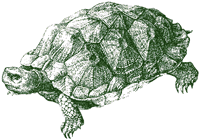
Hard Shells



 Appearance: This specie of Hard Shell is well adapted to survival in the harsh environment of the desert. Its scaly reptilian skin is tough and protects against dehydration. Its rock hard domed shell is excellent protection against hungry predators, except for the ingenious humans and elves. The Hard Shell's sharp claws and strong legs provide the tools needed to dig deep burrows in the sandy soil. They can live up to 100 years in the wild.
Appearance: This specie of Hard Shell is well adapted to survival in the harsh environment of the desert. Its scaly reptilian skin is tough and protects against dehydration. Its rock hard domed shell is excellent protection against hungry predators, except for the ingenious humans and elves. The Hard Shell's sharp claws and strong legs provide the tools needed to dig deep burrows in the sandy soil. They can live up to 100 years in the wild.
 Feeding: This reptile makes the most of limited food and water resources. Hard Shells depend on water-rich grasses, plants, and flowers for food. Hard Shells relish spring and summer rains and seek out puddles where water collects. They store water within their bodies in a specialized urinary bladder. When water is scarce, they depend upon this internal water reserve to survive. The best opportunities for viewing Hard Shells out and about are spring and summer season mornings, early evenings and during rainstorms
Feeding: This reptile makes the most of limited food and water resources. Hard Shells depend on water-rich grasses, plants, and flowers for food. Hard Shells relish spring and summer rains and seek out puddles where water collects. They store water within their bodies in a specialized urinary bladder. When water is scarce, they depend upon this internal water reserve to survive. The best opportunities for viewing Hard Shells out and about are spring and summer season mornings, early evenings and during rainstorms
Breeding: Hard Shells hatch from small eggs laid within burrows and reach maturity at about 15 years of age. For the first five years, life is risky for the small soft-shelled hatchlings, as they often fall prey to various desert predators.
Hard Shells Uses: They have succulent meat that makes an excellent stew. Their hard shells can be used for a variety of things. The domed shell is often made into bowls, for water, knick-knacks, or even stews and soups. The bottom plate can be used for plates, if needed. Their shells can also be used to make beads for various decorations.